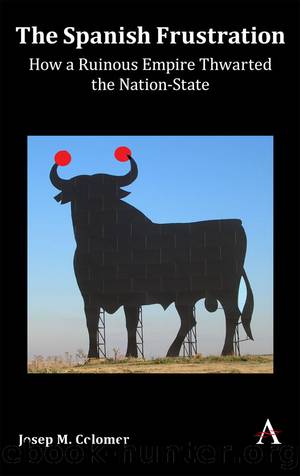The Spanish Frustration by Colomer Josep M.;

Author:Colomer, Josep M.;
Language: eng
Format: epub
Publisher: Book Network Int'l Limited trading as NBN International (NBNi)
Tribes with Flags and Chants
National symbols are the main diffusers of nationalist values among the citizens of a state; they simplify ideological national identities and also contribute to shaping their contents. Together with historical myths and heroes, monuments and maps, festivities and commemorations, the main national symbols are the flag and the national anthem.
Diplomat and journalist Tim Marshall explains that “flags are a relatively recent phenomenon in human history,” as they became feasible only after the Chinese invention of silk, a light fabric that, in contrast to traditional weighty standards in cloth, could be held aloft even in battlefields. With its spread in modern times, “a nation’s flag fluttering in the wind is a sign of power, hope, history, and often war […] For thousands of years, flags have stood for our identities and ideals. We have them, burn them, and march under their colors. And still, in the 21st century, we die for them […] They represent the politics of high power as well as the passions of the mob.” In the particular case of Spain, flags are a dramatic representation of political power in its factionalism and the wicked passions of divided mobs.12
The choice of a Spanish national flag was divisive from the beginning. By the late eighteenth century, the Royal Navy had replaced the traditional insignia in white with the Bourgogne cross with a flag with two horizontal stripes, one in red and one in yellow to make it more visible on the open sea. But at the Parliament of Cadiz or at the popular uprisings against Napoleon by the early nineteenth century, there was not a single flag that could identify all the Spaniards and encourage national patriotism. The navy emblem was adopted as the flag of the army and the militia in 1843. But still by the end of the nineteenth century, many inhabitants of Spain did not know of it and even some recruited soldiers were unable to identify it when they arrived at the barracks.
The further entrenchment of the bicolor or “rojigualda” flag in the minds of the Spaniards during the twentieth century involved its mixing with religious ceremonies, wars and repression. The Law of military Jurisdictions of 1906, above mentioned, established prison penalties for those who, by any means, “outrage the Nation, its flag, national anthem or other emblem of its representation.” Soon thereafter, the bicolor flag began to be raised in all public buildings, especially on religious festivities such as Easter, Corpus Christi, Santiago and the Immaculate Conception. The dictatorship of Primo de Rivera in the 1920s adamantly associated the flag with the colonial adventures in Northern Africa and it added “offenses to national emblems” to the criminal code. The bicolor Spanish monarchist flag was also adopted by the rebels against the Republic and became the official flag of the Franco dictatorship. In the 1940s, it introduced the crime of propaganda by any means aiming at “destroying or relaxing the national sentiment.” Up until the late 1960s, students could be condemned to several years of prison for “outrages to the national flag.
Download
This site does not store any files on its server. We only index and link to content provided by other sites. Please contact the content providers to delete copyright contents if any and email us, we'll remove relevant links or contents immediately.
The Secret History by Donna Tartt(18840)
The Social Justice Warrior Handbook by Lisa De Pasquale(12141)
Thirteen Reasons Why by Jay Asher(8791)
This Is How You Lose Her by Junot Diaz(6778)
Weapons of Math Destruction by Cathy O'Neil(6139)
Zero to One by Peter Thiel(5684)
Beartown by Fredrik Backman(5594)
The Myth of the Strong Leader by Archie Brown(5421)
The Fire Next Time by James Baldwin(5246)
How Democracies Die by Steven Levitsky & Daniel Ziblatt(5127)
Promise Me, Dad by Joe Biden(5087)
Stone's Rules by Roger Stone(5026)
100 Deadly Skills by Clint Emerson(4840)
A Higher Loyalty: Truth, Lies, and Leadership by James Comey(4840)
Rise and Kill First by Ronen Bergman(4701)
Secrecy World by Jake Bernstein(4640)
The David Icke Guide to the Global Conspiracy (and how to end it) by David Icke(4624)
The Farm by Tom Rob Smith(4434)
The Doomsday Machine by Daniel Ellsberg(4415)
